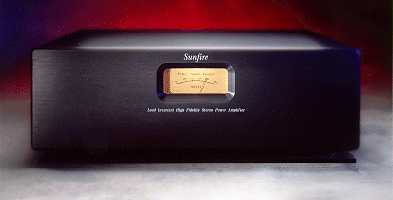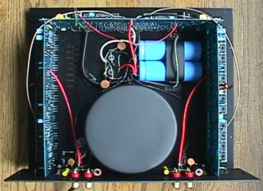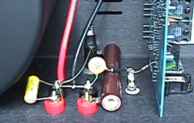By John E. Johnson, Jr.
 |
Sunfire Solid State Power Amplifier - Class AB, 300 watts/ch into 8 Ohms, 600 watts/ch into 4 Ohms, 1200 watts/ch into 2 Ohms, 2400 watts/ch into 1 Ohm (all values rms), frequency response 1 Hz - 80 kHz, balanced and unbalanced inputs, input impedance 470 kOhm, output impedance 0.01 Ohm (voltage source), 1 Ohm (current source), size 6"H x 19"W x 15"D, weight 43 pounds. $2,175. Sunfire Corporation, 5210 Bickford Avenue, Snohomish, Washington 98290, (206) 335-4748.
The Sunfire amplifier represents the third generation design from Bob Carver (the first generation being at Phase Linear, the second at Carver Corporation, and now the third at Sunfire Corporation). Bob has always focused special effort on power supplies, and this is no exception. Using a tracking downconverter which employs massive Hexfet rectifiers, the unit will deliver 2400 watts per channel into 1 Ohm on a short term basis. Bipolar transistors are used in the amplifier section, and these solid state devices are known for their ability to drive low impedance speakers, but unless the power supply can deliver the necessary current and voltage, this capability will not be realized. The Sunfire certainly meets the requirement for power supply delivery.
In a conventional class AB amplifier, heat is a substantial problem when high output occurs. This is because approximately three times the audio power is dissipated as heat at one third the distance up each side of the waveform. For example, if the amplifier is delivering 100 watts per channel during a particular musical passage, 300 watts per channel are being dissipated as heat for a portion of the waveform. In a class A amplifier, at idle, four times the maximum available output is constantly being dissipated as heat. This is why high power class AB amplifiers and even modestly powered class A amplifiers often have massive heat sinks (fins) on the sides of the amplifier.
The Sunfire power supply converts high voltage with moderate current to low voltage with high current and maintains an output of 6-8 volts above the signal voltage, rather than a constant voltage. In this way, when the signal is low, the power supply voltage is low, and as the signal increases, the power supply voltage also increases. Thus, very little energy is dissipated as heat. Indeed, we found that even when our speakers were driven hard, the amplifier remained at just slightly above room temperature.
The Sunfire is a very smart looking piece
of equipment, brushed anodized black aluminum, with a power meter
(in Joules, a representation of the energy stored in the power
supply capacitors) on the front, illuminated with a yellow incandescent
bulb. The power meter remains at 380 Joules unless driven into
clipping, when it would tend to decrease. However, we were not
able to drive it into clipping, as the meter never budged from
its 380 Joule reading.  Utilizing
mini-monitors rated at 300 watts power handling capability, and
ribbon speakers capable of handling 800 watts each, we played
orchestral music as loud as we could stand it, and music with
deep, intense kettle drum thuds, but to no avail; the Sunfire
would simply not be overdriven. This is a dynamite muscle amplifier!
The inside of the chassis shows why this amp is so tough. Power
supply! The shielded transformer, bridged rectifier, and power
supply capacitors take up almost the entire chassis.
Utilizing
mini-monitors rated at 300 watts power handling capability, and
ribbon speakers capable of handling 800 watts each, we played
orchestral music as loud as we could stand it, and music with
deep, intense kettle drum thuds, but to no avail; the Sunfire
would simply not be overdriven. This is a dynamite muscle amplifier!
The inside of the chassis shows why this amp is so tough. Power
supply! The shielded transformer, bridged rectifier, and power
supply capacitors take up almost the entire chassis.
The sonic personality of the Sunfire depends
on which type of output you choose. For those who prefer the crispness
of solid state amplifiers, there is a voltage source output, and
for tube sound lovers, there is a current source output. The voltage
source output sound was characterized by one of our staff as "blue
white", that is, crisp and clean, without any apparent coloration.
The current source output, on the other hand, has a warmer characteristic
to it, similar to (but not identical to, of course) a tube amplifier
sound.  Bob Carver recommends a bi-wiring
configuration, in which the current source outputs are connected
to the mid-range drivers and tweeters, while the voltage source
outputs are connected to the woofers. In this way, the current
source outputs, with their moderate impedance (1 Ohm resistor
placed in series with the output of each channel - see photo at
right - the long brown cylinder is the resistor) will produce
a warm sound in the mid and high ranges, and the voltage source
outputs, with their low impedance (0.01 Ohm) will produce a very
tight bass that tube amplifiers usually cannot do. Bob also suggests
using the current source outputs for ribbon and electrostatic
speakers. This is because these types of speakers tend to be very
fast in reproducing high frequencies, and thus, with some CDs
that are a bit edgy, the current source outputs will produce a
sound that is not overly crisp. However, it all depends on your
taste, and this unique amplifier gives you a choice not available
in other amplifier designs.
Bob Carver recommends a bi-wiring
configuration, in which the current source outputs are connected
to the mid-range drivers and tweeters, while the voltage source
outputs are connected to the woofers. In this way, the current
source outputs, with their moderate impedance (1 Ohm resistor
placed in series with the output of each channel - see photo at
right - the long brown cylinder is the resistor) will produce
a warm sound in the mid and high ranges, and the voltage source
outputs, with their low impedance (0.01 Ohm) will produce a very
tight bass that tube amplifiers usually cannot do. Bob also suggests
using the current source outputs for ribbon and electrostatic
speakers. This is because these types of speakers tend to be very
fast in reproducing high frequencies, and thus, with some CDs
that are a bit edgy, the current source outputs will produce a
sound that is not overly crisp. However, it all depends on your
taste, and this unique amplifier gives you a choice not available
in other amplifier designs.
Negative feedback is often employed to lower the output impedance of amplifiers, so, at first glance, one might assume that there is simply more negative feedback in the voltage source circuit than the current source circuit of the Sunfire. However, this is not the case, as the same amount of feedback is present in both the voltage source and current source circuits. Approximately 22 dB of negative feedback are inserted at 500 Hz and above, while at 200 Hz, 40 dB are utilized. The negative feedback employed in the Sunfire is a combination of current feedback, which raises the output impedance, and voltage feedback, which lowers it. The two outputs (voltage source and current source) have a different balance of the two types of feedback, resulting in their distinctive output impedances and sonic personalities. The slew rate for the voltage source is 15V/microsec, and 12V/microsec for the current source. The lower slew rate for the current source is in agreement with its slightly warmer sound quality.
Sibilants (the "s" in words emitted by the human voice) were natural, comparing favorably with the clarity of sibilants produced by a pure class A single ended triode tube amplifier, not exactly, but oh, so close. This indicates that the Sunfire has well designed circuits that are using negative feedback to correct only those issues that are inherent in all push pull solid state amplifiers.
At typical listening levels, total harmonic distortion is at 0.02%, and at full output, is rated at 0.5% throughout the audible frequency band (20 Hz - 20 kHz). Use of the balanced inputs reduced hum significantly when challenged by hum inducing configurations.
There is no power on/off switch, in keeping with the trend in audio product design to leave the equipment on at all times. With the superb energy conserving power supply design in the Sunfire, this is easy to live with. However, if you wish to turn it off after a listening session, use of a high quality AC line conditioner, some of which have remote control capability, will take care of the situation (this is what we utilize for turning most of our reference equipment on or off).
The Sunfire amplifier represents state of the art in high definition audio design. Although it is a fine piece of equipment to listen to any type of music, it would also be a great choice for home theater. We connected the Sunfire to the left/right front channels of a surround sound system, and there were no movie sound tracks that it could not handle. Gunshots, explosions, Jurassic Park, Terminator 2, Return of the Jedi: You name it, the Sunfire handled it with ease. And that is without any subwoofers! (Our surround sound reference system uses ribbon speakers with their own woofers, capable of frequency reproduction down to about 20 Hz.)
For the present, one Sunfire would be fine, since the rear channel is frequency band limited in most cases, and is not supposed to be very loud in any case. However, down the road lurks digital surround with a full range audio spectrum in all channels, except the subwoofer. At that point, a second, and maybe even a third Sunfire would make a home theater system to end all systems (air raid helmets required). This would provide six channels of amplification: two for the front left/right, two for the rear, one for the center channel, and one for the subwoofer. This represents a lot of money, but this is a lot of amplifier. If you plan on purchasing a self powered subwoofer, then two Sunfires would suffice (utilizing the "phantom mode" for the center channel).
In sum, the Sunfire is musically equivalent to any of the best solid state class AB amplifiers we have tested, and has the power to meet absolutely any demands that may be placed on it, except for arc welding an automobile chassis. Congratulations, Bob, for another landmark product.
John E. Johnson, Jr.
Editor-in-Chief
Other related articles
© Copyright 1995, 1996, 1997, 1998 Secrets of Home Theater & High Fidelity
Return to Table of Contents for this Issue.

